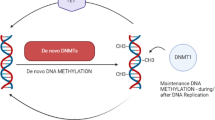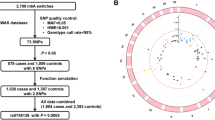Abstract
The basic mechanisms underlying promoter DNA hypermethylation in cancer are still largely unknown. It has been proposed that the levels of the methyl donor group in DNA methylation reactions, S-adenosylmethionine (SAMe), might be involved. SAMe levels depend on the glycine-N-methyltransferase (GNMT), a one-carbon group methyltransferase, which catalyzes the conversion of SAMe to S-adenosylhomocysteine in hepatic cells. GNMT has been proposed to display tumor suppressor activity and to be frequently repressed in hepatocellular carcinoma (HCC). In this study, we show that GNMT shows aberrant DNA hypermethylation in some HCC cell lines and primary tumors (20 %). GNMT hypermethylation could contribute to gene repression and its restoration in cell lines displaying hypermethylation-reduced tumor growth in vitro. In agreement, human primary tumors expressing GNMT were of smaller size than tumors showing GNMT hypermethylation. Genome-wide analyses of gene promoter methylation identified 277 genes whose aberrant methylation in HCC was associated with GNMT methylation/expression. The findings in this manuscript indicate that DNA hypermethylation plays an important role in the repression of GNMT in HCC and that loss of GNMT in human HCC could promote the establishment of aberrant DNA methylation patterns at specific gene promoters.





Similar content being viewed by others
References
Jemal A, Bray F, Center MM, Ferlay J, Ward E, Forman D (2011) Global cancer statistics. CA Cancer J Clin 61:69–90
Forner A, Llovet JM, Bruix J (2012) Hepatocellular carcinoma. Lancet 379:1245–1255
Bruix J, Sherman M (2011) Management of hepatocellular carcinoma: an update. Hepatology 53:1020–1022
Marrero JA, Fontana RJ, Fu S, Conjeevaram HS, Su GL, Lok AS (2005) Alcohol, tobacco and obesity are synergistic risk factors for hepatocellular carcinoma. J Hepatol 42:218–224
Fracanzani AL, Conte D, Fraquelli M, Taioli E, Mattioli M, Losco A, Fargion S (2001) Increased cancer risk in a cohort of 230 patients with hereditary hemochromatosis in comparison to matched control patients with non-iron-related chronic liver disease. Hepatology 33:647–651
El-Serag HB, Hampel H, Javadi F (2006) The association between diabetes and hepatocellular carcinoma: a systematic review of epidemiologic evidence. Clin Gastroenterol Hepatol 4:369–380
Bugianesi E, Leone N, Vanni E, Marchesini G, Brunello F, Carucci P, Musso A, De Paolis P, Capussotti L, Salizzoni M et al (2002) Expanding the natural history of nonalcoholic steatohepatitis: from cryptogenic cirrhosis to hepatocellular carcinoma. Gastroenterology 123:134–140
Thorgeirsson SS, Grisham JW (2002) Molecular pathogenesis of human hepatocellular carcinoma. Nat Genet 31:339–346
Kanai Y, Ushijima S, Hui AM, Ochiai A, Tsuda H, Sakamoto M, Hirohashi S (1997) The E-cadherin gene is silenced by CpG methylation in human hepatocellular carcinomas. Int J Cancer 71:355–359
Ito T, Nishida N, Fukuda Y, Nishimura T, Komeda T, Nakao K (2004) Alteration of the p14(ARF) gene and p53 status in human hepatocellular carcinomas. J Gastroenterol 39:355–361
Wong IH, Lo YM, Zhang J, Liew CT, Ng MH, Wong N, Lai PB, Lau WY, Hjelm NM, Johnson PJ (1999) Detection of aberrant p16 methylation in the plasma and serum of liver cancer patients. Cancer Res 59:71–73
Kerr SJ (1972) Competing methyltransferase systems. J Biol Chem 247:4248–4252
Uthus EO, Ross SA, Davis CD (2006) Differential effects of dietary selenium (se) and folate on methyl metabolism in liver and colon of rats. Biol Trace Elem Res 109:201–214
Augoustides-Savvopoulou P, Luka Z, Karyda S, Stabler SP, Allen RH, Patsiaoura K, Wagner C, Mudd SH (2003) Glycine N-methyltransferase deficiency: a new patient with a novel mutation. J Inherit Metab Dis 26:745–759
Mudd SH, Cerone R, Schiaffino MC, Fantasia AR, Minniti G, Caruso U, Lorini R, Watkins D, Matiaszuk N, Rosenblatt DS et al (2001) Glycine N-methyltransferase deficiency: a novel inborn error causing persistent isolated hypermethioninaemia. J Inherit Metab Dis 24:448–464
Chen YM, Shiu JY, Tzeng SJ, Shih LS, Chen YJ, Lui WY, Chen PH (1998) Characterization of glycine-N-methyltransferase-gene expression in human hepatocellular carcinoma. Int J Cancer 75:787–793
Liu HH, Chen KH, Shih YP, Lui WY, Wong FH, Chen YM (2003) Characterization of reduced expression of glycine N-methyltransferase in cancerous hepatic tissues using two newly developed monoclonal antibodies. J Biomed Sci 10:87–97
Martinez-Chantar ML, Vazquez-Chantada M, Ariz U, Martinez N, Varela M, Luka Z, Capdevila A, Rodriguez J, Aransay AM, Matthiesen R et al (2008) Loss of the glycine N-methyl transferase gene leads to steatosis and hepatocellular carcinoma in mice. Hepatology 47:1191–1199
Farber E, Ichinose H (1958) The prevention of ethionine-induced carcinoma of the liver in rats by methionine. Cancer Res 18:1209–1213
Pascale RM, Marras V, Simile MM, Daino L, Pinna G, Bennati S, Carta M, Seddaiu MA, Massarelli G, Feo F (1992) Chemoprevention of rat liver carcinogenesis by S-adenosyl-l-methionine: a long-term study. Cancer Res 52:4979–4986
Shivapurkar N, Hoover KL, Poirier LA (1986) Effect of methionine and choline on liver tumor promotion by phenobarbital and DDT in diethylnitrosamine-initiated rats. Carcinogenesis 7:547–550
Balaghi M, Horne DW, Wagner C (1993) Hepatic one-carbon metabolism in early folate deficiency in rats. Biochem J 291(Pt 1):145–149
Ogawa H, Gomi T, Takusagawa F, Fujioka M (1998) Structure, function and physiological role of glycine N-methyltransferase. Int J Biochem Cell Biol 30:13–26
Wagner C, Briggs WT, Cook RJ (1985) Inhibition of glycine N-methyltransferase activity by folate derivatives: implications for regulation of methyl group metabolism. Biochem Biophys Res Commun 127:746–752
Pascale RM, Simile MM, De Miglio MR, Nufris A, Daino L, Seddaiu MA, Rao PM, Rajalakshmi S, Sarma DS, Feo F (1995) Chemoprevention by S-adenosyl-l-methionine of rat liver carcinogenesis initiated by 1,2-dimethylhydrazine and promoted by orotic acid. Carcinogenesis 16:427–430
Liao YJ, Liu SP, Lee CM, Yen CH, Chuang PC, Chen CY, Tsai TF, Huang SF, Lee YH, Chen YM (2009) Characterization of a glycine N-methyltransferase gene knockout mouse model for hepatocellular carcinoma: implications of the gender disparity in liver cancer susceptibility. Int J Cancer 124:816–826
Yang AS, Estecio MR, Doshi K, Kondo Y, Tajara EH, Issa JP (2004) A simple method for estimating global DNA methylation using bisulfite PCR of repetitive DNA elements. Nucleic Acids Res 32:e38
Livak KJ, Schmittgen TD (2001) Analysis of relative gene expression data using real-time quantitative PCR and the 2(-delta delta C(T)) method. Methods 25:402–408
Mosmann T (1983) Rapid colorimetric assay for cellular growth and survival: application to proliferation and cytotoxicity assays. J Immunol Methods 65:55–63
Shechter D, Dormann HL, Allis CD, Hake SB (2007) Extraction, purification and analysis of histones. Nat Protoc 2:1445–1457
Ruthenburg AJ, Allis CD, Wysocka J (2007) Methylation of lysine 4 on histone H3: intricacy of writing and reading a single epigenetic mark. Mol Cell 25:15–30
Zhang C, Li H, Zhou G, Zhang Q, Zhang T, Li J, Zhang J, Hou J, Liew CT, Yin D (2007) Transcriptional silencing of the TMS1/ASC tumour suppressor gene by an epigenetic mechanism in hepatocellular carcinoma cells. J Pathol 212:134–142
Fernandez AF, Assenov Y, Martin-Subero JI, Balint B, Siebert R, Taniguchi H, Yamamoto H, Hidalgo M, Tan AC, Galm O et al (2012) A DNA methylation fingerprint of 1628 human samples. Genome Res 22:407–419
Ohm JE, McGarvey KM, Yu X, Cheng L, Schuebel KE, Cope L, Mohammad HP, Chen W, Daniel VC, Yu W et al (2007) A stem cell-like chromatin pattern may predispose tumor suppressor genes to DNA hypermethylation and heritable silencing. Nat Genet 39:237–242
Schlesinger Y, Straussman R, Keshet I, Farkash S, Hecht M, Zimmerman J, Eden E, Yakhini Z, Ben-Shushan E, Reubinoff BE et al (2007) Polycomb-mediated methylation on Lys27 of histone H3 pre-marks genes for de novo methylation in cancer. Nat Genet 39:232–236
Widschwendter M, Fiegl H, Egle D, Mueller-Holzner E, Spizzo G, Marth C, Weisenberger DJ, Campan M, Young J, Jacobs I et al (2007) Epigenetic stem cell signature in cancer. Nat Genet 39:157–158
Mudd SH, Brosnan JT, Brosnan ME, Jacobs RL, Stabler SP, Allen RH, Vance DE, Wagner C (2007) Methyl balance and transmethylation fluxes in humans. Am J Clin Nutr 85:19–25
Rowling MJ, McMullen MH, Schalinske KL (2002) Vitamin A and its derivatives induce hepatic glycine N-methyltransferase and hypomethylation of DNA in rats. J Nutr 132:365–369
Appanah R, Dickerson DR, Goyal P, Groudine M, Lorincz MC (2007) An unmethylated 3′ promoter-proximal region is required for efficient transcription initiation. PLoS Genet 3:e27
Deaton AM, Webb S, Kerr AR, Illingworth RS, Guy J, Andrews R, Bird A (2011) Cell type-specific DNA methylation at intragenic CpG islands in the immune system. Genome Res 21:1074–1086
Liu SP, Li YS, Chen YJ, Chiang EP, Li AF, Lee YH, Tsai TF, Hsiao M, Huang SF, Chen YM (2007) Glycine N-methyltransferase−/− mice develop chronic hepatitis and glycogen storage disease in the liver. Hepatology 46:1413–1425
Luka Z, Capdevila A, Mato JM, Wagner C (2006) A glycine N-methyltransferase knockout mouse model for humans with deficiency of this enzyme. Transgenic Res 15:393–397
Wang YC, Tang FY, Chen SY, Chen YM, Chiang EP (2011) Glycine-N methyltransferase expression in HepG2 cells is involved in methyl group homeostasis by regulating transmethylation kinetics and DNA methylation. J Nutr 141:777–782
Metcalf D, Greenhalgh CJ, Viney E, Willson TA, Starr R, Nicola NA, Hilton DJ, Alexander WS (2000) Gigantism in mice lacking suppressor of cytokine signalling-2. Nature 405:1069–1073
Schultheis B, Carapeti-Marootian M, Hochhaus A, Weisser A, Goldman JM, Melo JV (2002) Overexpression of SOCS-2 in advanced stages of chronic myeloid leukemia: possible inadequacy of a negative feedback mechanism. Blood 99:1766–1775
Sutherland KD, Lindeman GJ, Choong DY, Wittlin S, Brentzell L, Phillips W, Campbell IG, Visvader JE (2004) Differential hypermethylation of SOCS genes in ovarian and breast carcinomas. Oncogene 23:7726–7733
Buckbinder L, Velasco-Miguel S, Chen Y, Xu N, Talbott R, Gelbert L, Gao J, Seizinger BR, Gutkind JS, Kley N (1997) The p53 tumor suppressor targets a novel regulator of G protein signaling. Proc Natl Acad Sci U S A 94:7868–7872
Liang G, Bansal G, Xie Z, Druey KM (2009) RGS16 inhibits breast cancer cell growth by mitigating phosphatidylinositol 3-kinase signaling. J Biol Chem 284:21719–21727
Cheng CJ, Lin YC, Tsai MT, Chen CS, Hsieh MC, Chen CL, Yang RB (2009) SCUBE2 suppresses breast tumor cell proliferation and confers a favorable prognosis in invasive breast cancer. Cancer Res 69:3634–3641
Sherman M (2010) The resurrection of alphafetoprotein. J Hepatol 52:939–940
Acknowledgments
We wish to thank Dr. Zigmund Luka (Department of Biochemistry, Vanderbilt University Medical Center, Nashville, USA) for providing the pCEP4 and pCEP4-GNMT constructs, the CIC biogune Metabolomics platform for technical assistance, and OIB (FICYT) and Marino Santirso for editorial assistance. This work has been financially supported by FIS (FI07/00380 to C.H.; PI11/01830 to JB), FICYT (BP11138 to EGT), IUOPA (to RMR), AECC (to RGU), the FIS/FEDER (PI11/01728) and the ISCIII (CP11/00131; to AFF); the Spanish Ministry of Health (PI061267; PS09/02454 to MFF); the Spanish National Research Council (CSIC; 200820I172 to MFF); the Community of Asturias (FYCIT IB09-106 to MFF). The Cancer Epigenetics Laboratory (IUOPA) also thanks Mutua Madrileña and Ramón Areces Foundations for financial support. The IUOPA is supported by the Obra Social Cajastur, Spain. NIH grants RO1AT1576, RO1AT004896 (MLM-C and J.M.M.), RO1DK051719 (J.M.M.) Spanish Plan National of I+D SAF 2011-29851 (to J.M.M), ETORTEK-2010 Gobierno Vasco (to MLM-C and JMM), Sanidad Gobierno Vasco 2008 and Educación Gobierno Vasco 2011 (to MLM-C), PI11/01588 (to MLM-C). CIBERehd is funded by Instituto de Salud Carlos III.
Disclosure
The authors declare no conflict of interests related to this study.
Author information
Authors and Affiliations
Corresponding author
Additional information
Covadonga Huidobro and Estela G. Toraño contributed equally to this work.
Electronic supplementary material
Below is the link to the electronic supplementary material.
ESM 1
PDF 29.6 kb
Rights and permissions
About this article
Cite this article
Huidobro, C., Toraño, E.G., Fernández, A.F. et al. A DNA methylation signature associated with the epigenetic repression of glycine N-methyltransferase in human hepatocellular carcinoma. J Mol Med 91, 939–950 (2013). https://doi.org/10.1007/s00109-013-1010-8
Received:
Revised:
Accepted:
Published:
Issue Date:
DOI: https://doi.org/10.1007/s00109-013-1010-8




